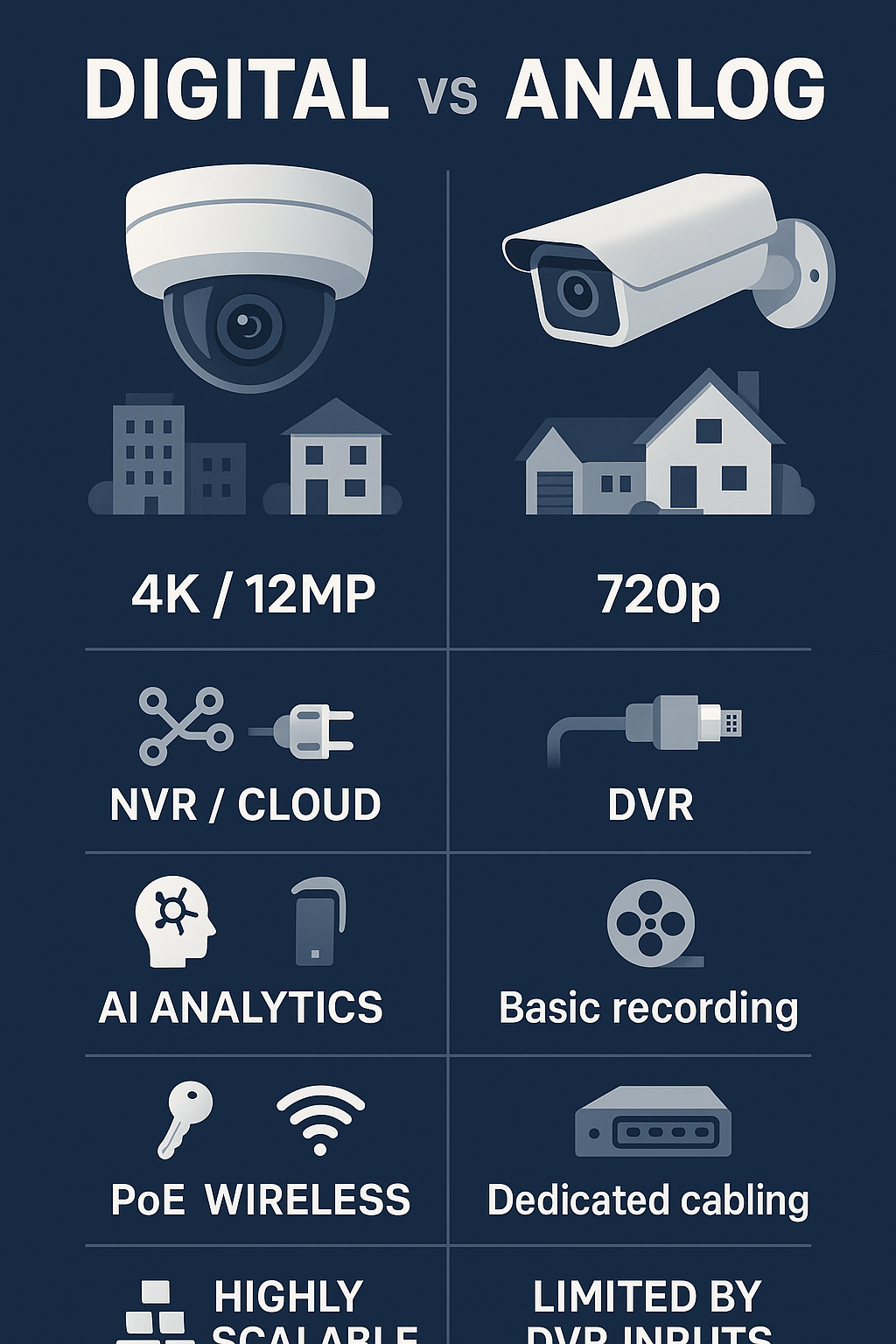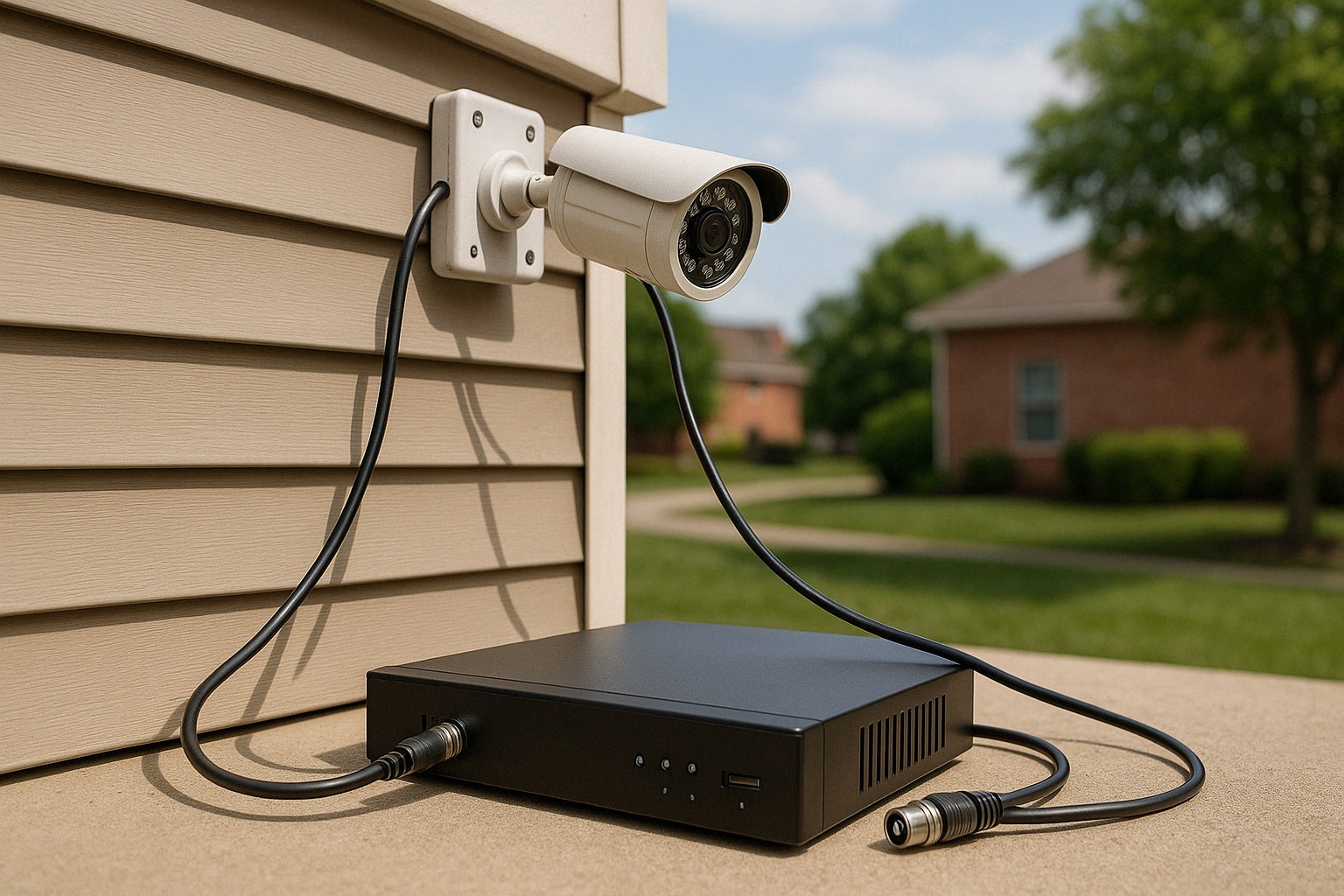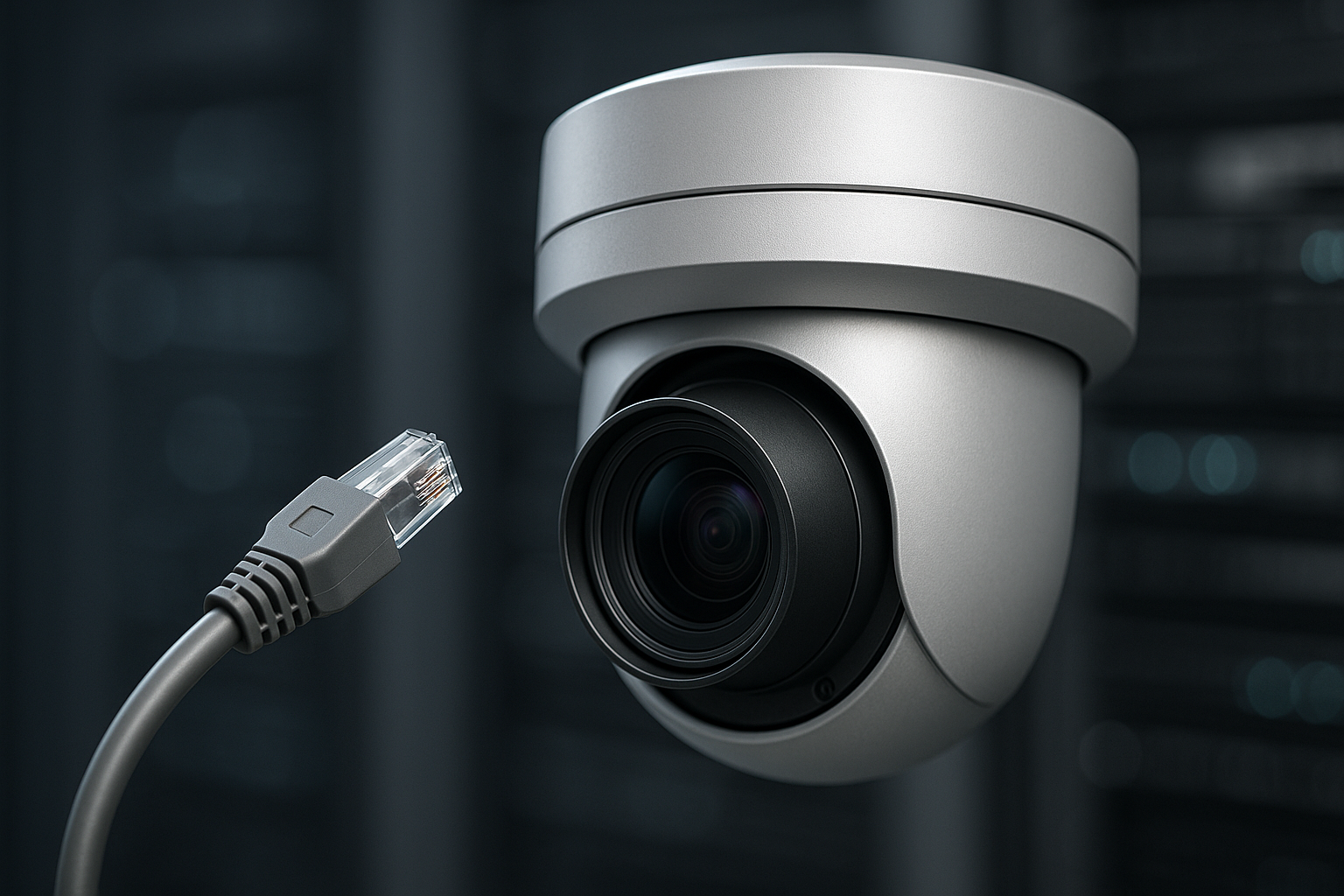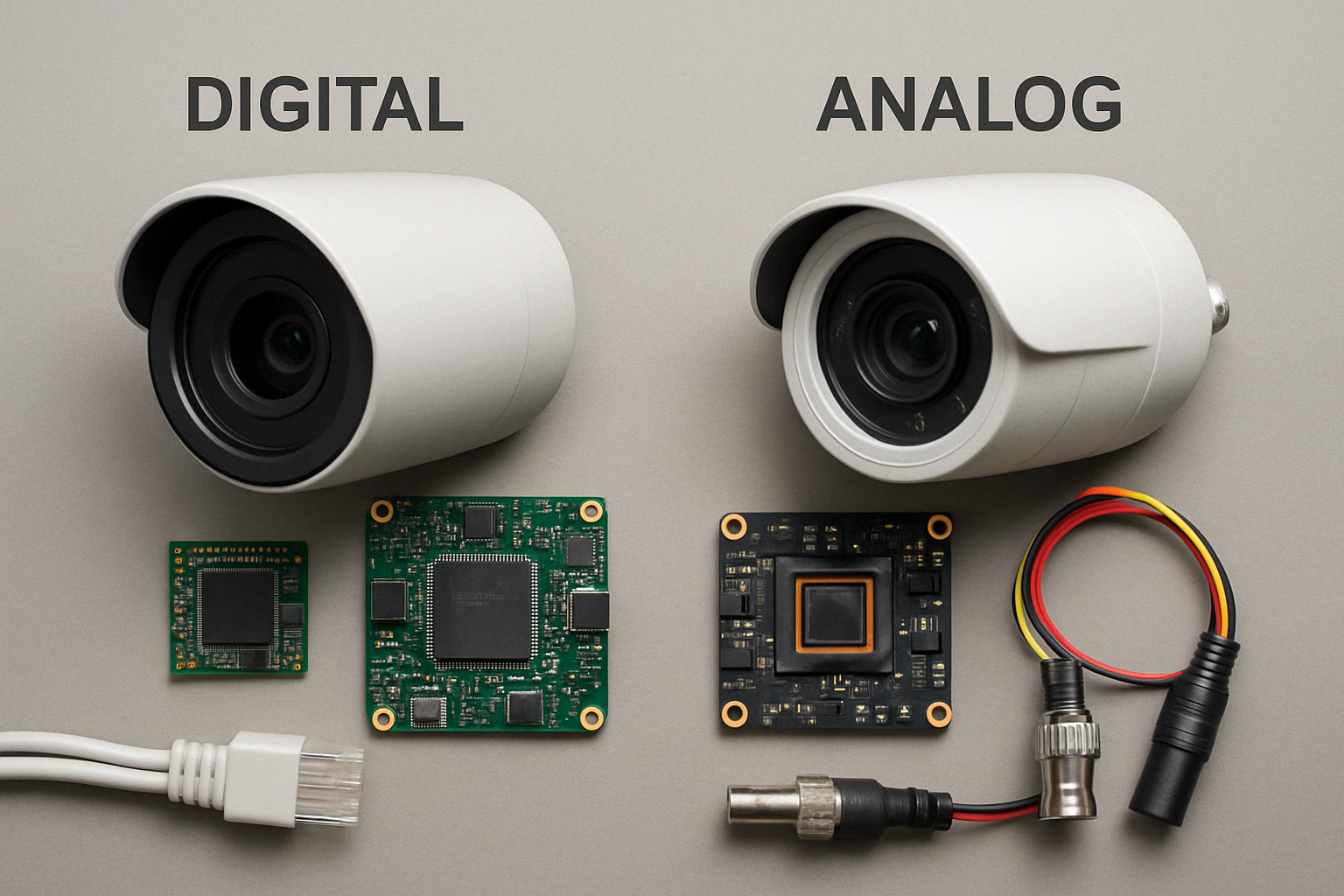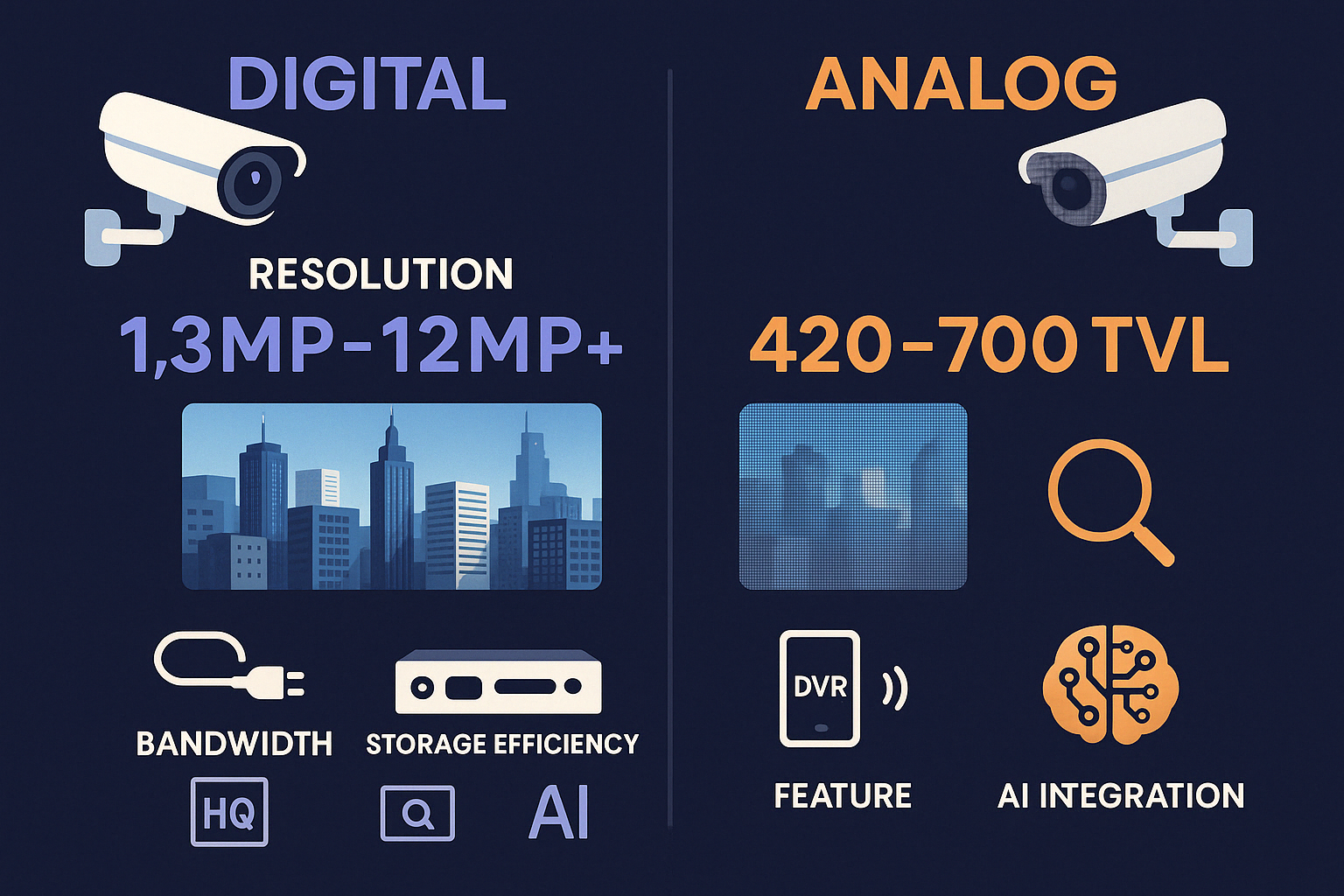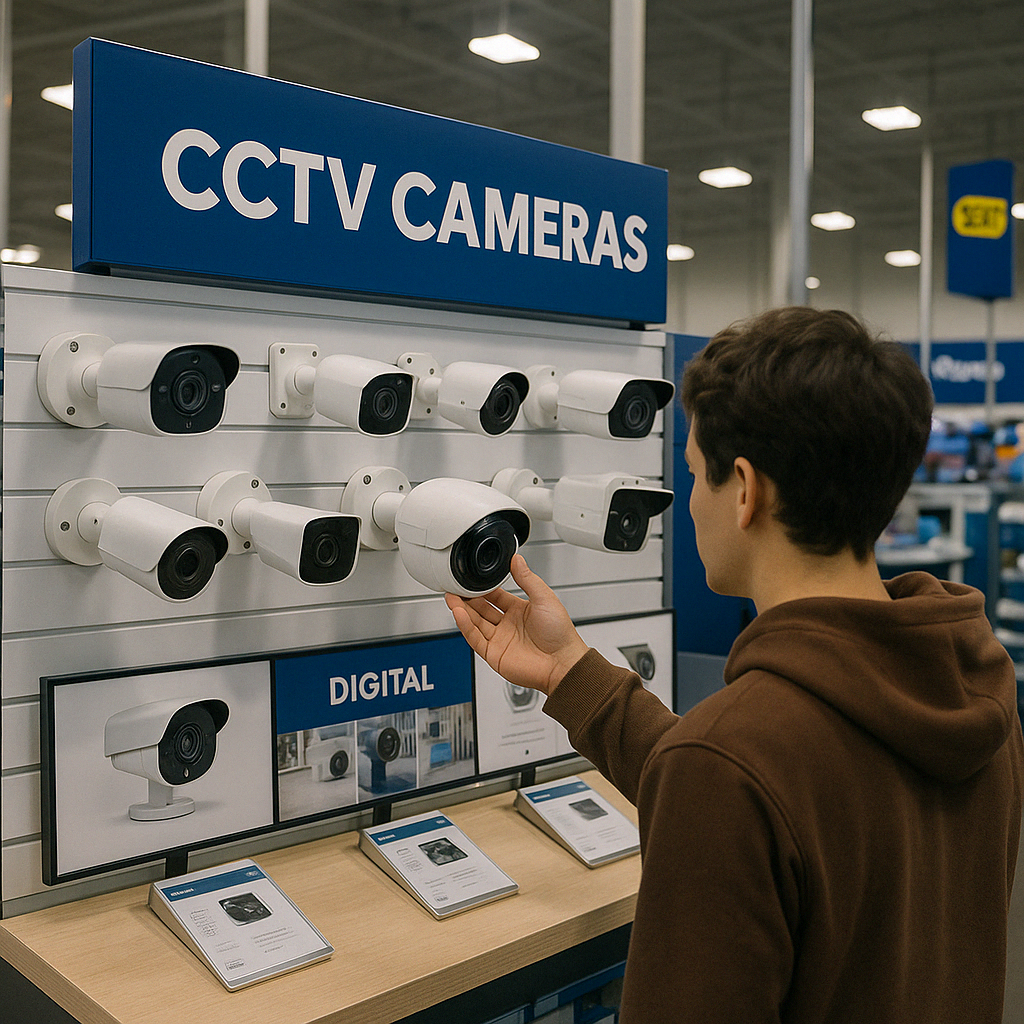Digital CCTV Camera: Top 5 Powerful Reasons to Upgrade
Understanding Modern Surveillance: Digital vs Analog
Digital CCTV cameras are network-connected devices that capture, process, and transmit high-resolution video data over IP networks, offering advanced features like remote viewing, AI analytics, and flexible storage options.
If you’re comparing digital and analog CCTV cameras, here’s what you need to know:
| Feature | Digital CCTV Camera | Analog CCTV Camera |
|---|---|---|
| Resolution | Up to 4K/12MP | Typically limited to 720p |
| Network | IP-based, works over Ethernet or WiFi | Requires coaxial cables |
| Storage | NVR or cloud-based | DVR system |
| Features | AI analytics, remote access, PTZ control | Basic recording, limited features |
| Installation | PoE or wireless options | Requires dedicated cabling |
| Scalability | Highly scalable, easy to add cameras | Limited by DVR inputs |
In today’s security-conscious world, digital CCTV cameras have revolutionized how we protect our properties. These modern surveillance solutions offer significantly improved capabilities over their analog predecessors, providing property managers like you with clearer images, smarter analytics, and more flexible installation options.
The shift from analog to digital surveillance represents one of the most significant advancements in security technology. While traditional CCTV systems have served us well for decades, digital IP cameras now deliver superior performance that can make a real difference in preventing crime and responding to incidents.
Whether you’re upgrading an existing system or installing surveillance for the first time, understanding the differences between these technologies is crucial for making the right investment in your property’s security.
Digital cctv camera helpful reading:
– latest cctv camera
– cctv camera with ip address
– cctv monitoring security
What is CCTV?
CCTV, or Closed-Circuit Television, is the watchful guardian that keeps an eye on your property when you can’t. Unlike the television shows that beam into millions of homes, CCTV operates on a “closed circuit” – sending video signals to specific monitors or recording devices for your eyes only.
Think of CCTV as your property’s silent sentinel. These surveillance systems monitor and record activities in virtually any environment – from cozy homes and small boutiques to sprawling corporate campuses and busy public spaces. Whether you’re protecting a family residence in Houston or a commercial complex in Dallas, CCTV serves as your ever-vigilant security partner.
The heart of any CCTV system is protection. These systems deter would-be troublemakers, capture crucial evidence when incidents occur, and provide that invaluable peace of mind we all seek for our homes and businesses. It’s like having an extra set of eyes that never blinks, never tires, and never takes a coffee break.
The evolution of CCTV technology tells a fascinating story of innovation. What began decades ago as simple analog cameras with basic recording has transformed into sophisticated digital CCTV cameras with crystal-clear imaging, smart detection features, and the ability to check in on your property from anywhere in the world using just your smartphone.
Here in America, CCTV has become as common as apple pie, with an estimated 70 million security cameras keeping watch across the nation. In our home state of Texas, where American S.E.A.L. Patrol Division proudly serves communities, security cameras have become an essential ingredient in the recipe for comprehensive protection – whether for your family home or your thriving business.
The fundamental difference between old-school analog CCTV and modern digital CCTV cameras comes down to how they capture, process, and share video information. Analog systems operate much like the VCRs of yesteryear, while digital systems leverage the same technology that powers our smartphones and computers. Understanding these differences isn’t just technical trivia – it’s the key to choosing the right security solution for your unique needs.
As we explore deeper into these technologies, you’ll find which approach makes the most sense for your property’s protection – because at American S.E.A.L., we believe the best security comes from making informed choices.
Understanding Analog CCTV Cameras
When you think about security cameras, those boxy cameras with the visible wires might come to mind first. These are analog CCTV cameras, the traditional workhorses of surveillance that have been keeping watch for more than 25 years. They capture video using analog signals and send that information through coaxial cables to a Digital Video Recorder (DVR), which converts and stores the footage.
Analog cameras typically deliver standard definition video with resolutions between 420 and 700 TV lines. In today’s terms, that’s roughly equivalent to 380p to 540p resolution. While this was perfectly acceptable a decade ago, it now looks quite grainy compared to the crystal-clear footage we’ve become accustomed to on our smartphones and TVs.
The beauty of analog technology lies in its simplicity. There’s something reassuringly straightforward about how these cameras work, making them accessible even if you’re not particularly tech-savvy.
How Do Analog CCTV Cameras Work?
Analog cameras operate through a remarkably straightforward process. First, the camera lens focuses light onto an image sensor (usually a CCD or CMOS chip). This sensor converts the light into an electrical signal – essentially translating what the camera “sees” into information that can travel through cables.
This electrical signal then journeys through coaxial cable – those round, somewhat rigid cables you might recognize – all the way back to the DVR. Each camera needs its own dedicated cable running directly to the recording unit, which is why you’ll often see bundles of cables in older security setups.
When the signal reaches the DVR, it’s converted from analog to digital format and stored on the DVR’s hard drive. You can then view this footage on monitors connected to the DVR system.
“Analog systems convert raw video into a format that can be stored on DVRs, providing continuous recording capabilities,” explains one of our security experts at American S.E.A.L. Patrol Division. “However, the quality is limited by the transmission medium and the conversion process.”
These systems do have physical limitations. The signal can only travel about 300-500 meters through standard coaxial cable before it starts to degrade noticeably. For larger properties, this means you might need signal boosters or amplifiers, which adds another layer of complexity to your security setup.
Benefits and Drawbacks of Analog CCTV Cameras
Like that reliable old pickup truck that keeps running year after year, analog CCTV systems have stuck around for good reasons, though they do come with their share of limitations.
On the positive side, analog cameras are typically more budget-friendly upfront than their digital counterparts. Their mature technology makes them straightforward to understand and troubleshoot when problems arise. There’s also a certain reliability that comes with simpler technology – fewer complex components often means fewer things that can go wrong.
Another advantage is cross-brand compatibility – analog cameras from different manufacturers generally play nice together, allowing you to mix and match as needed. And perhaps most reassuringly, they don’t depend on network infrastructure to function at a basic level, meaning they’ll keep recording even if your internet goes down.
However, the drawbacks are significant in today’s high-tech world. The limited resolution (maxing out around 700 TVL or roughly 960×480 pixels) simply can’t compete with modern HD and 4K options. Each camera requires its own dedicated coaxial cable running all the way back to the DVR, making installation more challenging and less flexible, especially in larger buildings.
These coaxial cables are also vulnerable to interference from nearby electrical equipment and even lightning strikes. And if you want to add more cameras later, you might need additional DVR hardware and more cable runs, making expansion a headache.
Perhaps most significantly, analog systems lack many of the advanced features we’ve come to expect, like intelligent video analytics, convenient remote viewing, or useful digital zoom capabilities. Most analog cameras also have fixed lenses without optical zoom options, limiting what you can see.
“While analog systems still have their place, particularly in budget-conscious applications,” we’ve observed at American S.E.A.L. Patrol Division, “they simply can’t match the capabilities and future-proofing offered by digital CCTV cameras. We’ve seen many clients upgrade after realizing the limitations of their analog systems during critical security incidents.”
For smaller properties with basic security needs and tight budgets, analog might still be a reasonable choice. But for most modern applications, the limitations of analog technology are becoming increasingly apparent as digital options continue to advance and become more affordable.
For more information about traditional CCTV systems, you can visit Wikipedia’s CCTV article which provides a comprehensive history of surveillance technology.
Understanding Digital CCTV Cameras
Welcome to the future of surveillance! Digital CCTV cameras, often called IP cameras, have completely transformed how we protect our homes and businesses. Think of these modern marvels as tiny computers with eyes – they don’t just see; they process, analyze, and communicate what they see across networks.
Unlike the old-school analog cameras that simply capture and transmit raw signals, digital CCTV cameras are smart devices that turn what they see into digital information packets. This fundamental difference changes everything about how surveillance works.
The clarity is remarkable – while analog cameras topped out at around 700 TVL (roughly equivalent to standard definition TV), today’s digital CCTV cameras start at 1.3 megapixels and can go all the way up to 12MP or beyond. To put that in perspective, a mid-range 5MP camera gives you about five times more detail than the best analog camera ever could. This means you can actually zoom in on recorded footage later and still clearly see faces, license plates, or other crucial details.
How Do Digital CCTV Cameras Work?
The magic of a digital CCTV camera happens in several neat steps. First, light enters through the lens and hits a digital image sensor (similar to what’s in your smartphone). But instead of simply converting this to an analog signal, the camera’s internal processor – its brain – transforms this raw data into digital video and compresses it using advanced formats like H.264 or H.265.
Each camera operates as its own network device with a unique IP address. Once processed, the video data travels over your Ethernet network or WiFi connection to a Network Video Recorder (NVR), which stores all this digital information. The beauty of this system is that you can access your footage through multiple devices – your NVR, computer, or even your smartphone when you’re away from home.
One of our clients in Houston recently told me, “I was at my daughter’s soccer game when I got an alert. I pulled up the camera on my phone and saw someone checking my door handles. I called police while watching them in real-time – they were caught two blocks away.”
“IP cameras capture raw video, convert it to a digital stream, and transmit it to a Network Video Recorder (NVR) for storage. This digital approach eliminates many of the quality and distance limitations of analog systems.”
Perhaps the most practical advantage of digital CCTV cameras is their use of Power over Ethernet (PoE) technology. This clever innovation allows both power and data to flow through a single Ethernet cable, making installation cleaner and simpler than the multi-cable mess required by analog systems.
These cameras don’t necessarily need internet access to function – they can operate perfectly well on a local network. However, connecting them to the internet opens up remote viewing possibilities, letting you check on your property from anywhere in the world with an internet connection.
Benefits and Drawbacks of Digital CCTV Cameras
When we install digital CCTV camera systems for clients across Houston, they’re often amazed by the difference compared to older systems they’ve used. The benefits are substantial and immediately noticeable.
The image quality is truly exceptional, with crystal-clear footage that makes identification of people and objects much more reliable. This clarity has helped numerous clients provide conclusive evidence to law enforcement when needed.
The smart features built into these cameras make them far more than passive observers. Many models can distinguish between a person, animal, or vehicle, sending you specific alerts based on what they detect. Some can even recognize familiar faces or detect unusual activities like someone lingering too long in one area.
Installation flexibility is another huge advantage. We can use your existing network infrastructure, run a single PoE cable to each camera, or even set up wireless cameras in hard-to-reach locations. This adaptability makes digital CCTV cameras suitable for virtually any property.
The ability to access your cameras remotely provides peace of mind that was simply impossible with analog systems. Whether you’re on vacation or just at work, you can check in on your property with a few taps on your smartphone.
As your security needs grow, digital CCTV cameras grow with you. Adding new cameras to your network is straightforward and doesn’t require completely new infrastructure each time you expand.
Of course, there are some considerations to keep in mind. The initial investment for digital systems is typically higher than analog equivalents, though this gap has narrowed significantly in recent years. These systems also rely on your network infrastructure, so having a reliable network is important for optimal performance.
High-resolution cameras can use significant bandwidth, particularly when multiple cameras are streaming simultaneously. And as with any network device, proper cybersecurity measures are essential to prevent unauthorized access to your cameras.
There’s also a bit more technical complexity involved in setting up and maintaining digital systems, though at American S.E.A.L. Patrol Division, we handle all of that for you so you don’t need to become a network expert overnight.
Over the past five years, we’ve installed hundreds of digital CCTV camera systems throughout Texas, and the feedback has been overwhelmingly positive. From homeowners who finally feel secure to business owners who’ve reduced theft and improved employee safety, these modern surveillance systems have proven their worth time and again.
Digital CCTV Camera vs. Analog CCTV Camera: Key Differences
When comparing digital CCTV cameras to analog systems, several key differences become apparent. Understanding these distinctions is crucial for making an informed decision about which technology best suits your security needs.
Let’s take a closer look at how these two technologies stack up against each other. The differences go far beyond just image quality – they extend to installation requirements, flexibility, and the overall capabilities you can expect from your security system.
| Feature | Digital CCTV Camera | Analog CCTV Camera |
|---|---|---|
| Resolution | 1.3MP to 12MP+ (1080p to 4K and beyond) | 420-700 TVL (roughly 380p-540p) |
| Image Quality | Sharp, detailed images with accurate colors | Lower detail, may be grainy or blurry, especially in low light |
| Zoom Capability | Digital zoom without quality loss (within resolution limits) | Digital zoom with significant quality degradation |
| Transmission | Network cables (CAT5e/CAT6) or wireless | Coaxial cables (RG-59 or RG-6) |
| Power | PoE (Power over Ethernet) or separate power | Separate power supply required |
| Recording Device | Network Video Recorder (NVR) | Digital Video Recorder (DVR) |
| Cabling Distance | Up to 100m with standard Ethernet (extendable with switches) | 300-500m with standard coaxial (signal degradation beyond) |
| Storage Efficiency | Better compression, smart recording options | Continuous recording, less efficient |
| Remote Viewing | Native capability through apps/web browsers | Requires additional hardware/software |
| Analytics | Built-in capabilities like motion detection, line crossing, object counting | Limited or none (requires external processing) |
| AI Integration | Many cameras support advanced AI features | Not available |
| Scalability | Easy to add cameras to network | Limited by DVR inputs and cabling |
| Cybersecurity | Requires proper network security measures | Less vulnerable (closed system) |
| Audio | Many models include built-in microphones or audio inputs | Requires separate audio system |
| Integration | Works with other IP-based systems | Limited integration capabilities |
The numbers tell part of the story, but what do these differences mean in real-world situations? Let’s break it down in practical terms.
Image quality is perhaps the most noticeable difference. When we install digital CCTV cameras for our Houston clients, they’re often amazed at the clarity. One property manager told us, “I can actually read the text on delivery packages from my front door camera now!” This level of detail simply isn’t possible with analog systems.
In fact, our security team recently helped solve a case where a digital CCTV camera captured a license plate number from over 50 feet away – something that would have been impossible with even the best analog camera.
Installation flexibility is another major advantage of digital systems. With analog cameras, each device needs its own dedicated cable running all the way back to your DVR. It’s like having to run a separate water pipe from the street to every faucet in your house – inefficient and messy.
Digital CCTV cameras can use your existing network infrastructure, and many can even connect wirelessly. Plus, with Power over Ethernet (PoE) technology, a single cable provides both power and data – making installation cleaner, faster, and more cost-effective for larger properties.
The intelligence built into modern digital CCTV cameras is truly impressive. Many of our clients are surprised to learn their cameras can distinguish between people, vehicles, and animals – automatically filtering out false alarms from things like swaying trees or passing shadows. Some cameras can even recognize specific faces or alert you when someone lingers in a designated area for too long.
“With analog cameras, you might be able to tell that someone entered your property, but identifying specific features can be challenging,” explains our senior security consultant. “With high-resolution digital CCTV cameras, you can clearly see faces, read license plates, and capture small details that could be crucial evidence.”
Remote access capabilities have also transformed how our clients use their security systems. Being able to check in on your property from anywhere in the world, receive instant alerts, and even speak through two-way audio features has made security systems more interactive and useful day-to-day. While some analog systems can be retrofitted with internet connectivity, these features come standard with digital systems.
Scalability is another factor worth considering. Adding cameras to an analog system often means running new cables and possibly upgrading your DVR if you’ve maxed out its inputs. With digital CCTV cameras, adding new devices to your network is relatively simple, making it easier to expand your security coverage as your needs grow.
The one area where analog systems still hold an advantage is in initial cost. If you’re working with an extremely tight budget and only need basic surveillance, analog might make sense. However, when factoring in installation costs, future expansion, and the superior capabilities of digital systems, the value proposition often tilts heavily toward digital CCTV cameras for most of our clients.
For most property owners in Texas, the decision ultimately comes down to whether the superior performance and features of digital systems justify the higher initial investment. In our experience at American S.E.A.L. Patrol Division, the answer is usually yes – especially when considering the long-term benefits and peace of mind that comes with having clear, detailed footage when you need it most.
Factors to Consider When Choosing Between Digital and Analog CCTV Cameras
Choosing between analog and digital CCTV cameras doesn’t have to feel like solving a complex puzzle. Here in Houston, we’ve helped hundreds of property owners make this decision, and it really comes down to understanding a few key factors that matter most for your specific situation.
Image Quality and Resolution
Let’s be honest – image quality is probably the first thing most of us notice when comparing camera systems. The difference between analog and digital CCTV cameras can be striking.
Think about what you actually need to see. If you’re just wanting to know if someone entered your backyard, even a basic camera might do the trick. But if you need to identify who that person was, resolution becomes crucial.
For clear facial recognition, you’ll want at least 2MP (1080p) resolution, though our clients get much better results with 4-5MP cameras. We installed these at a local retail store last year, and the owner told me, “After upgrading from analog to 4MP digital CCTV cameras, we were finally able to clearly identify shoplifters. The difference in image quality paid for itself within the first three months.”
Need to capture license plates? You’ll want to step up to at least 4MP, with proper positioning and good lighting. And for large areas like parking lots or warehouses, higher resolutions (5MP+) let you digitally zoom in while maintaining important details.
In good lighting, here’s roughly how far different resolutions can capture facial details:
– 1080P (2MP): Up to 25 feet
– 4MP: Up to 45 feet
– 8MP (4K): Up to 55 feet
– 12MP: Up to 70 feet
We’ve found 4MP and 5MP cameras hit that sweet spot of excellent detail without breaking the bank for most commercial applications.
Installation and Infrastructure
The way cameras connect to your recording system makes a huge difference in installation complexity and cost.
Analog systems require two separate cables for each camera – one for video (coaxial) and another for power. This means more drilling, more cable management, and more potential points of failure. Plus, there’s a distance limit of about 300-500 meters before the signal starts to degrade.
Digital CCTV cameras simplify things considerably. Most use Power over Ethernet (PoE), meaning a single network cable carries both power and data. As our lead technician often says, “Installing one CAT6 cable with PoE is much faster and cleaner than running separate coaxial and power cables. This can reduce installation time by 30-40% in most cases.”
If you already have coaxial cables installed, don’t worry! There are hybrid solutions that let you use existing cabling while getting some digital benefits through formats like HD-CVI, HD-TVI, or AHD.
Digital systems also offer wireless options for those hard-to-reach places where running cables would be impractical or too expensive. And since they connect to your network, you can easily add cameras as your needs grow.
Advanced Features and Analytics
This is where digital CCTV cameras really shine. They’re essentially mini-computers with lenses, capable of analyzing what they see and acting on it.
Modern digital cameras can tell the difference between a person, a car, and your neighbor’s cat wandering through your property. They can alert you when someone crosses a virtual line you’ve drawn on the screen or lingers in an area too long. Some can even recognize faces or license plates.
A property manager at one of the apartment complexes we serve in Houston told me, “The line crossing alerts have been incredibly useful—we receive immediate notifications when someone enters restricted areas, allowing our security team to respond proactively rather than reviewing footage after an incident.”
Digital cameras also handle challenging environments better. They adjust to changing light conditions (WDR), automatically switch to night vision mode when it gets dark, and many come with built-in infrared illumination for seeing in complete darkness.
Many models even support two-way audio, allowing you to speak to visitors (or warn potential intruders) through the camera. Try doing that with an analog system!
Cost Considerations
Let’s talk dollars and sense. Yes, digital CCTV cameras typically cost more upfront than their analog counterparts. Analog cameras might run $30-150 each, while digital IP cameras generally range from $80-500+ depending on features and resolution.
The recording equipment follows a similar pattern – DVRs for analog systems ($200-500 for 4-16 channels) cost less than NVRs for digital systems ($300-1000+ for similar capacity).
But initial purchase price is just one piece of the puzzle. With analog, you’ll spend more on cabling (separate video and power runs) and installation labor. Digital systems generally need less cabling and installation time, potentially offsetting some of that higher upfront cost.
Then there’s the long-term value to consider. Digital systems are more future-proof, with software updates often adding new features over time. They’re easier to expand when you need more cameras. And most importantly, they’re simply more effective at what matters most – preventing security incidents and providing clear evidence when needed.
As I often tell our clients at American S.E.A.L. Patrol Division, “The true cost of a security system isn’t just what you pay upfront—it’s also measured by its effectiveness in preventing incidents and providing usable evidence when needed.”
When you factor in all these considerations, the value proposition of digital CCTV cameras becomes much clearer, even with the higher initial investment. For most of our clients, the benefits of clearer images, advanced features, and simpler installation make digital the smarter long-term choice.
Frequently Asked Questions about Digital CCTV Cameras
Do Digital CCTV Cameras Need the Internet to Work?
This is probably one of the questions we hear most often when talking with new clients at American S.E.A.L. Patrol Division. I’m happy to clear this up: digital CCTV cameras don’t actually need internet access to perform their basic functions.
Think of IP cameras as operating on a network, but that network doesn’t have to be connected to the internet. It can be completely self-contained within your property. In this setup:
Your cameras connect to a Network Video Recorder (NVR) through Ethernet cables or your local WiFi
The NVR handles recording and storing all your footage on its internal hard drives
You can watch live video on monitors directly connected to the NVR
So why do people think internet is required? Because internet connectivity does open up some pretty useful features:
You can check your camera feeds from your phone when you’re away from home
Cloud storage gives you an off-site backup if something happens to your NVR
You’ll receive instant notifications on your phone when motion is detected
Your system can automatically update its time and firmware
As Carlos, our technical director, often tells clients: “Internet isn’t a requirement—it’s an improvement. Your cameras will capture everything just fine without it, but you’ll need internet if you want to check those cameras while you’re sitting on a beach in Galveston!”
For most of our Houston clients, we recommend setting up systems that can work independently on their local network while also connecting to the internet for remote access. This gives you the best of both worlds—your security doesn’t fail during internet outages, but you still get all those convenient remote features when your connection is working.
Can Digital CCTV Cameras Record Audio?
Yes! Many digital CCTV cameras can capture audio either through built-in microphones or by connecting external audio devices. This feature adds another dimension to your security footage, providing context that video alone might miss.
But—and this is important—there are some serious legal considerations when recording audio:
Texas is what’s called a “one-party consent” state, which means you can legally record conversations if you’re participating in them or if at least one person in the conversation has given permission. However, recording private conversations between other people without anyone’s knowledge could potentially violate privacy laws.
Public spaces generally have lower privacy expectations, but that doesn’t mean there are no rules.
Because of these legal nuances, we typically advise our clients to:
Post clear notices informing people that audio recording is in progress
Turn off audio recording in areas where private conversations are likely
Check with a lawyer about your specific situation to stay on the right side of the law
When used appropriately, audio recording proves incredibly valuable. One of our retail clients in west Houston installed audio-enabled cameras at their returns counter, which helped them resolve several customer disputes and actually improved their staff training.
Modern digital CCTV cameras with audio capabilities often include some impressive features:
Two-way audio that lets you speak through the camera (great for telling delivery people where to leave packages)
Audio analytics that can detect specific sounds like breaking glass or shouting
Noise filtering technology that improves the clarity of recorded sound
Compression systems that keep audio files from eating up all your storage space
How Do I Choose Between Wired and Wireless Digital CCTV Cameras?
This is like the classic “paper or plastic” question of the security world—both options have their place, and the right choice really depends on your specific situation.
Wired (PoE) IP Cameras are the workhorses of professional security systems:
They provide rock-solid reliability with consistent performance that doesn’t fluctuate
Power over Ethernet (PoE) technology eliminates the need for separate power cables
They’re much more difficult for someone to hack or jam than wireless systems
They typically support higher video quality without compression compromises
There’s no competition for wireless bandwidth with your other devices
Wired cameras make the most sense when:
You’re protecting high-value areas where reliability is non-negotiable
Your property allows for relatively easy cable installation
You need the absolute best video quality for identification purposes
You’re planning to record continuously 24/7
Wireless IP Cameras offer flexibility that wired systems can’t match:
Installation is significantly easier with no need to run cables through walls
You can place them almost anywhere within range of your WiFi network
They can be relocated as your security needs change
They’re perfect for temporary setups or rental properties
They’re ideal for historic buildings where drilling holes for cables isn’t an option
Wireless cameras shine brightest when:
Running cables would be prohibitively difficult or expensive
You need a security solution you can take with you when you move
You want to extend coverage to detached structures like a garage or shed
You need cameras up and running quickly
Maria, our installation manager, has a saying I love: “We use wired cameras where we must, and wireless cameras where we can.” For many of our Houston clients, a mixed approach works best—wired cameras for critical areas and main coverage, with wireless cameras filling in the gaps or covering those hard-to-reach spots.
If you do go wireless, just remember:
Your WiFi needs to reach all the areas you want to monitor
Other wireless devices might cause interference
Even “wireless” cameras need power from somewhere (usually an outlet)
You’ll want to take extra precautions to secure your wireless network
For larger properties, we sometimes install wireless mesh networks or dedicated wireless bridges to ensure cameras in far-flung locations maintain reliable connections back to the recording system.
Conclusion
The journey through surveillance technology brings us to a crossroads: analog or digital CCTV cameras? While both have their place, the security landscape is clearly shifting toward digital solutions for compelling reasons.
After helping hundreds of Houston businesses and homeowners improve their security over the past 15 years, we at American S.E.A.L. Patrol Division have witnessed how the right camera system can make all the difference. Not just in capturing evidence after an incident, but in actively preventing security breaches before they happen.
Digital CCTV cameras have revolutionized what’s possible in property protection. The crystal-clear imagery that allows you to identify faces from 50 feet away. The intelligent analytics that can distinguish between a stray cat and a potential intruder. The peace of mind that comes from checking in on your property from anywhere in the world with just a few taps on your smartphone.
For properties with existing analog infrastructure, hybrid solutions offer a practical stepping stone. You can leverage your current investment while gradually transitioning to the improved capabilities of digital technology—a pragmatic approach we often recommend to budget-conscious clients who still want improved security outcomes.
The reality is that security threats continue to evolve in sophistication, and your protection measures need to keep pace. Today’s digital CCTV cameras aren’t just recording devices; they’re intelligent security partners that can actively alert you to suspicious activities, integrate with other security systems, and provide valuable insights beyond simple surveillance.
One of our clients, a small business owner in downtown Houston, recently told us: “I used to review footage only after something happened. Now my system alerts me when someone approaches after hours, and I can actually speak to them through the camera. It’s completely changed how I think about security.”
That change from reactive to proactive security represents the true value of modern surveillance technology. It’s not just about having evidence after the fact—it’s about creating an environment where incidents are less likely to occur in the first place.
We understand that every property has unique security challenges and constraints. That’s why our team at American S.E.A.L. Patrol Division offers personalized consultations to assess your specific needs and recommend solutions custom to your situation. Whether you’re securing a family home, a retail space, or a large commercial property, we’ll help you steer the options and implement a system that provides genuine protection and peace of mind.
The most expensive security system isn’t necessarily the right one—but the right system, properly installed and configured, is an investment that pays dividends in safety and security for years to come.


